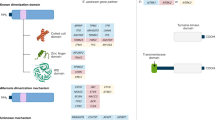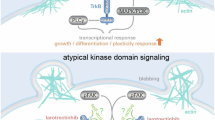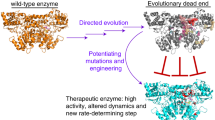Abstract
The trk oncogene is a human transforming gene generated by the fusion of tropomyosin gene sequences to a truncated tyrosine kinase receptor gene1. We have now characterized the normal tropomyosin gene from which the trk oncogene is derived. At least two different transcripts are expressed by this gene using a tissue-specific alternative messenger RNA splicing mechanism: a 2.5-kilobase (kb) mRNA encoding a 248-amino-acid tropomyosin in human fibroblasts and a 1.3-kb mRNA encoding a 285-amino-acid tropomyosin in human skeletal muscle. The rearrangement which generates the trk oncogene preserves most of the tropomyosin-coding sequences of the normal gene, including exons alternatively spliced in muscle and non-muscle tissue. We therefore expect the trk oncogene to show a tissue-specific pattern of transforming activity. Correct expression of the trk oncogene can occur only in non-muscle tissues. In muscle tissue the oncogene would almost certainly be inactive, as splicing according to the alternative muscle pattern aborts synthesis of the tryosine kinase domain.
This is a preview of subscription content, access via your institution
Access options
Subscribe to this journal
Receive 51 print issues and online access
$199.00 per year
only $3.90 per issue
Buy this article
- Purchase on SpringerLink
- Instant access to full article PDF
Prices may be subject to local taxes which are calculated during checkout
Similar content being viewed by others
References
Martin-Zanca, D., Hughes, S. H. & Barbacid, M. Nature 319, 743–748 (1986).
MacLeod, A. R. & Talbot, K. J. molec. Biol. 167, 523–537 (1983).
Karlik, C. C., Mahaffey, J. W., Coutu, M. D. & Fyrberg, E. A. Cell 37, 469–481 (1984).
Basi, G. S., Boardman, M. & Storti, R. V. Molec. cell. Biol. 4, 2828–2836 (1984).
Ruiz-Opazo, N., Weinberger, J. & Nadal-Ginard, B. Nature 315, 67–70 (1985).
MacLeod, A. R. et al. Proc. natn. Acad. Sci. U.S.A. 82, 7835–7839 (1985).
Stone, D. & Smillie, L. B. J. biol. Chem. 253, 1137–1148 (1978).
Lewis, W. G., Coté, G. P., Mak, A. S. & Smillie, L. B. FEBS Lett. 156, 269–273 (1983).
Scheller, R. H. et al. Cell 28, 707–719 (1982).
MacLeod, A. R. Nucleic Acids Res. 9, 2675–2689 (1981).
Henikoff, S. Gene 28, 351–359 (1984).
Karn, J., Brenner, S., Barnett, L. & Cesarini, G. Proc. natn. Acad. Sci. U.S.A. 71, 5172–5176 (1980).
Karn, J., Matthes, H. W. D., Gait, M. J. & Brenner, S. Gene 32, 217–234 (1984).
Sanders, C. & Smillie, L. B. J. biol. Chem. 260, 7264–7275 (1985).
Staden, R. Nucl. Acids. Res. 10, 2951–2961 (1982).
Author information
Authors and Affiliations
Rights and permissions
About this article
Cite this article
Reinach, F., MacLeod, A. Tissue-specific expression of the human tropomyosin gene involved in the generation of the trk oncogene. Nature 322, 648–650 (1986). https://doi.org/10.1038/322648a0
Received:
Accepted:
Issue date:
DOI: https://doi.org/10.1038/322648a0
This article is cited by
-
ETV6-NTRK3 transformation requires insulin-like growth factor 1 receptor signaling and is associated with constitutive IRS-1 tyrosine phosphorylation
Oncogene (2002)
-
Pathobiology of NPM-ALK and variant fusion genes in anaplastic large cell lymphoma and other lymphomas
Leukemia (2000)
-
Nemaline myopathy mechanisms
Nature Genetics (1995)
-
A disease locus for familial hypertrophic cardiomyopathy maps to chromosome 1q3
Nature Genetics (1993)
-
Evolution of tropomyosin functional domains: Differential splicing and genomic constraints
Journal of Molecular Evolution (1988)



